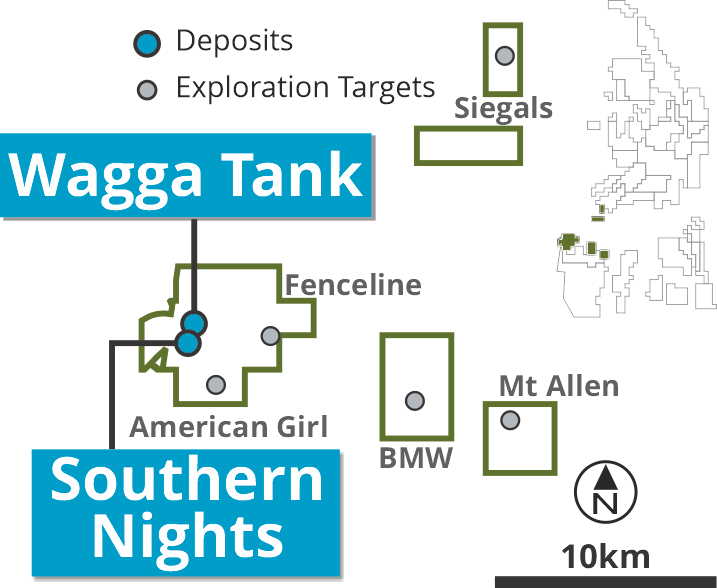Peel Mining
Southern Nights / Wagga Tank
Project Snapshot
Status
Pre-feasibility and Environmental Studies
Location
Western edge of the Cobar Superbasin, 130km south of Cobar or ~30km northwest of Mount Hope.
Area Size
87km2.
Ownership
100% Peel Mining Limited
Commodity
Copper, Lead, Zinc, Gold & Silver
Mineral Resource
Updated Mineral Resource January 2023
6.83 million tonnes at 3.92% zinc, 1.52% lead, 62 g/t silver containing approximately 268,000t zinc, 104,000t lead and 13.6 million ounces silver. (A$80/t NSR cut-off)

Overview
The Wagga Tank project, contained within Exploration Licence 6695 was previously held by MMG until 2016, where registration was finalised on 16th July 2016, and it became 100% Peel owned.
The project can be divided into two prospects: ‘Wagga Tank’ to the North and ‘Southern Nights’ ~1km to the South. They are located 130km south of Cobar and ~30km northwest of Mount Hope in central NSW. ‘Southern Nights’ was discovered by Peel in September 2017, from drillhole WTRCDD021 (which was testing coincident chargeable IP and magnetic geophysical anomalies), this revealed significant sulphide mineralisation (Zinc-Lead-Silver). Subsequent drilling at both ‘Wagga Tank’ and ‘Southern Nights’ has exposed economical massive sulphide mineralisation. Peel Mining Ltd anticipates a move towards an economic mine plan in the future.
Southerly Extension at Southern Nights
A short extensional drilling program was completed to test the southerly extent of mineralisation beyond previously drilled WTRCDD238, which hosts significant polymetallic mineralisation (35m @ 6.3% Zn, 2.59% Pb, 105g/t Ag, 0.24% Cu, 1.87g/t Au from 232m). The program confirmed that mineralisation remains open to the south.
Geology
The Cobar Basin developed as four deep-water troughs bordered by shallow-water shelves. Wagga Tank lies within the Mt Hope Trough, which is interpreted as a volcano-tectonic rift associated with a submarine cauldron. During the rift-phase, sub-aerial volcanism was followed by submarine, felsic volcanism. A-type volcanics occur along the major N-S structures and are overlain by S-type volcanics. Large accumulations of sediments and volcanics up to 2.5km thick were deposited (Scheibner, 1987).
The stratigraphic units which form the Wagga Tank / Southern Nights prospect are steeply west dipping and generally upright, they are made up of:
1) The Upper Amphitheatre Group / Mt Kennan Volcanics (the Wagga Tank formation)
Informally, known as the Wagga Tank Formation, which overlays the following units. It is comprised of shales, siltstones and less commonly sandstone (a turbidite facies). The Vivigani Formation, occurs underneath, often with a transitional contact and was formed prior to the Wagga Tank Fmn. The formation is a complexed volcanic package of coarse polymictic volcaniclastics, sandstones, breccias, mass debris flow breccias, rhyolitic/rhyodacitic lavas, peperites with minor shales/siltstone beds.
2) The Lower Amphitheatre Group
Informally called the Eastern Formation, it underlies the Vivigani Fmn with a sharp contact. This formation it is also made up of turbiditic facies of shales, silts and sandstones, making it very similar to the Wagga Tank Fmn in composition, however the Eastern formation can commonly be distinguished by the higher occurrence of sandstone beds, likely suggesting that it was formed in a higher energy / shallower marine environment than the more recent Wagga Tank Fmn.
Mineralisation
Mineralisation occurs in the form of Pyrite, Sphalerite, Galena and Chalcopyrite, commonly developing in veins (Stringer veins > Colloform veins), which frequently exhibit sulphide zonation, and Massive/Laminated sulphides.
The veins exclusively form in the footwall (within the Vivigani more than Eastern formation, this is surmised to have occurred due to the porosity and abundance of accommodation space in the unit).
The contact between the Wagga Tank and the Vivigani Fmn predominately hosts the bulk of mineralisation in for of massive/laminated sulphides. It is theorised that volcanic-hosted massive sulphides (VHMS) / volcanic-associated massive sulphides (VAMS) originate in a unit underlying the Eastern Fmn and percolate their way up through the Eastern and Vivigani Fmns, until they encounter the ocean floor (syngenetic with the formation of the Wagga Tank Fmn) and deposit in “pools” from volcanic vents (possible evidence seen within drill core), where they form massive/laminated sulphides.
Resource
The Southern Nights / Wagga Tank prospect has a 2.2km long strike, with the system remaining open along strike and down dip, A Maiden Mineral Resource released in July 2019 was subsequently upgraded in March 2020, and again in January 2023. The 2023 MRE comprises 6.83 million tonnes at 3.92% zinc, 1.52% lead, 62 g/t silver containing approximately 268,000t zinc, 104,000t lead and 13.6 million ounces silver (A$80/t NSR cut-off). Refer to ASX Announcement “20MT Resource Base for South Cobar Project” 9th January 2023.

The South Cobar Project MREs including Southern Nights Wagga Tank are above A$80/tonne NSR cut-off and utilises mineable shapes, which include minimum mining widths and internal dilution to bound the MREs. Figures are rounded to reflect the precision of estimates and include rounding errors.
The Southern Nights discovery and subsequent drilling also by Peel has exposed the prospect as one of the most significant zinc polymetallic findings in Australia’s recent years. However, the prospect remains a challenge due to the thick transported cover overlying the VMS-style mineral system.

